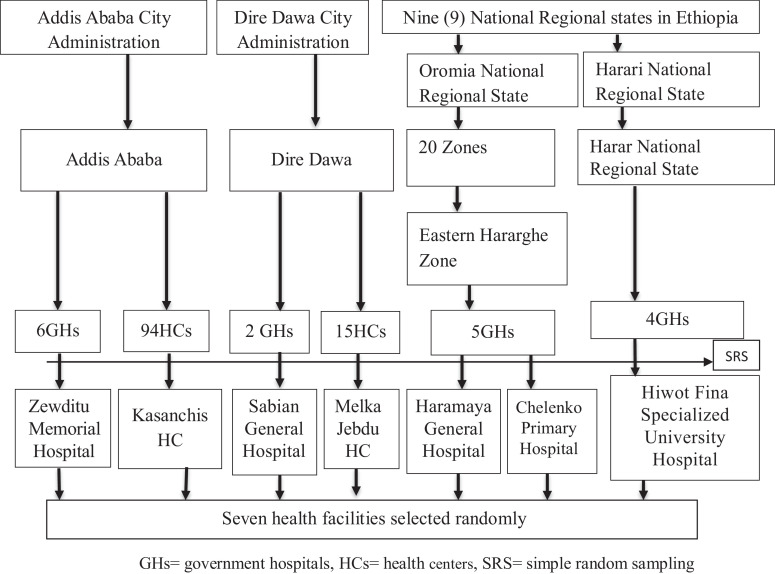One-third of tuberculosis (TB) circumstances in Ethiopia are lacking from look after causes that aren’t properly studied. The goal of this examine was to assess TB burden and establish challenges related to TB screening and diagnosis in Ethiopia.
A facility-based cross-sectional examine was carried out in seven well being services chosen from two areas and 2 metropolis administrations of Ethiopia utilizing stratified random sampling procedures.
The information of 1,059,065 sufferers have been included from outpatient division, HIV clinic, diabetic, and maternal-child well being clinics. Data have been collected from October to December 2018 utilizing a retrospective assessment of three years’ facility information (2015 to 2017) supplemented by a semi-structured interview with purposively chosen well being care employees and heads of the well being services.
ResultsA complete of 1,059,065 sufferers visited the well being services in three years, of these, 978,480 (92.4%) have been outpatients. Of the entire, 20,284 (2%) have been presumptive TB circumstances (with 14 days or extra cough), 12.2% (2483/20,284) of which had TB. For the kind of TB, 604 (24.3%) have been smear-positive pulmonary TB (PTB), 789 (31.8%) have been smear-negative PTB, 719 (29%) have been extra-pulmonary TB, and information have been lacking for the remaining.
TB screening was built-in into HIV clinic, outpatient division, diabetic clinic however not with the maternal and little one clinics. High affected person load, weak TB laboratory specimen referral system, and scarcity of TB diagnostic instruments together with Xpert MTB/RIF assay and chest X-ray, have been the most important challenges in the screening and diagnosis of TB.
The burden of TB was excessive in the examine setting, and frequent interruption of laboratory reagents and provides hampered TB screening and diagnostic companies. Realizing the END-TB technique in such resource-limited settings requires sustainable TB diagnostic capability and improved case detection mechanisms, with nationwide TB applications strongly built-in into the final well being care system.

Remodeling of the core leads HIV-1 pre-integration complicated in the nucleus of human lymphocytes.
Retroviral replication proceeds by obligate integration of the viral DNA into the host genome. In explicit, HIV-1 genome to enter the nucleus, should be led by the nuclear pore complicated (NPC). During HIV-1 cytoplasmic journey, the viral core acts like a shell to defend the viral genetic materials from antiviral sensors and guarantee an ample setting for the reverse transcription.
However, the comparatively slim measurement of the nuclear pore channel requires that the HIV-1 core reshapes right into a construction that matches the pore. On the opposite hand, the group of the viral CA proteins that stay related to the pre-integration complicated (PIC) throughout and after nuclear translocation remains to be enigmatic.
In this examine, we analysed the progressive organizational modifications of viral CA proteins inside the cytoplasm and the nucleus by immuno-gold labelling. Furthermore, we arrange a novel know-how, HIV-1 ANCHOR, which allows the precise detection of the retrotranscribed DNA by fluorescence microscopy, thereby providing the chance to uncover the structure of the potential HIV-1 PIC.
Thus, we mixed the immunoelectron microscopy and ANCHOR applied sciences to reveal the presence of DNA- and CA-positive complexes by correlated light- and electron microscopy (CLEM).
During and after nuclear translocation, HIV-1 seems as a posh of viral DNA adorned by a number of viral CA proteins remodelled in a “pearl necklace” form. Thus, we might describe how CA proteins reshape across the viral DNA to allow the doorway of the HIV-1 in the nucleus.
This explicit CA protein complicated composed by the integrase and the retrotranscribed DNA leads HIV-1 genome contained in the host nucleus.Our findings contribute to the understanding of the early steps of HIV-1 an infection and present new insights into the group of HIV-1 CA proteins throughout and after viral nuclear entry. Of notice, we at the moment are ready to visualize the viral DNA in viral complexes, opening up new views for future research on viral nuclear destiny.
